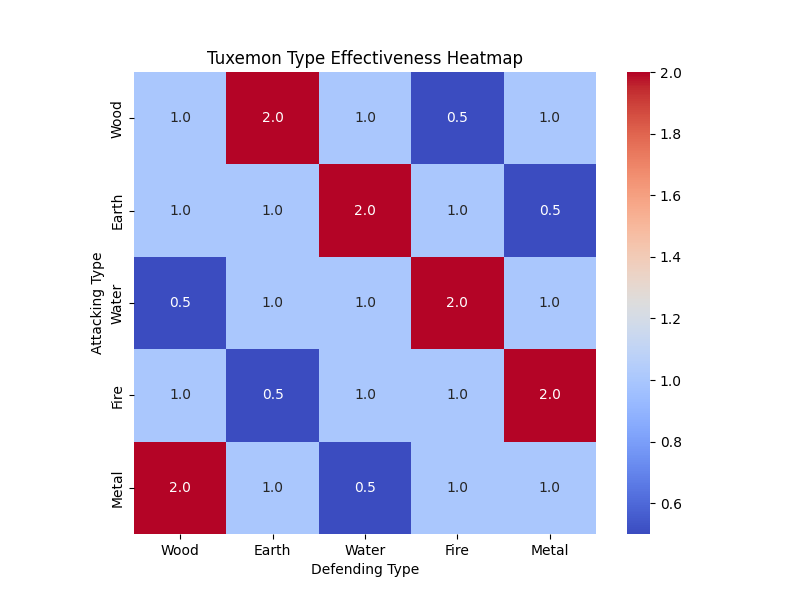Category:Type
Techniques and monsters have one or two types, reflecting their nature, behaviour and structure. Tuxemon has five types - Fire, Earth, Metal, Water and Wood.
There is an alternative type system with 13 types.
|
Background[edit | edit source]
Tuxemon's creature types are based on the five-element/five-agent theory of Wu Xing. The doctrine of five phases describes this:

Overcoming Cycle[edit | edit source]
- Wood parts Earth (such as roots; or, Trees can prevent soil erosion)
- Earth dams (or muddles or absorbs) Water
- Water extinguishes Fire
- Fire melts Metal
- Metal chops Wood
Generating Cycle[edit | edit source]
- Wood fuels Fire
- Fire leaves behind Earth (ash)
- Earth produces Metal
- Metal fortifies Water (minerals in water)
- Water nourishes Wood
Associations[edit | edit source]
- Fire: Includes creatures associated with energy, like electricity, light and heat, dragons and other legendary beings, and poison.
- Water: Includes creatures associated with the sea, lakes and swamps, ice and snow, the weather, liquids like blood, and fish and amphibians.
- Wood: Includes creatures associated with plants, lichen and fungi, poison and venom, forests, the natural environment, the wind and flying, and the wilderness.
- Earth: Includes creatures associated with the ground and underground, dirt and soil, mountains and rocks, caves, and ancient and buried things.
- Metal: Includes creatures associated with steel, light and darkness, mechanical and robotic things, psychic powers and other unnatural things, humankind, and the undead.
How it works[edit | edit source]
There are five options for strengths and weaknesses using the Wu Xing cycles:
- In A, an attack is weak against the element that it Generates and strong against the element that it Overcomes.
- In B, an attack is weak against the element that Overcomes it and strong against the element that Generates it.
- In C, an attack is weak against the element that it Generates, strong against the element that it Overcomes and strong against the element that Generates it.
- In D, an attack is weak against the element that Overcomes it, strong against the element that Generates it and strong against the element that it Overcomes.
- In E, an attack is weak against the element that it Generates, strong against the element that it Overcomes, weak against the element that Overcomes it and strong against the element that Generates it.
We have gone with model A at this point:
| tech/target | Wood | Earth | Water | Fire | Metal |
|---|---|---|---|---|---|
| Wood | 2 | 0.5 | |||
| Earth | 2 | 0.5 | |||
| Water | 0.5 | 2 | |||
| Fire | 0.5 | 2 | |||
| Metal | 2 | 0.5 |
Dual types/Pseudo-types[edit | edit source]
While the game only has five types, the existence of two-type monsters and techniques allows for different vulnerability and resistance profiles. We can therefore represent other "types".
For example, Earth-Fire techniques do half damage to Earth monsters and double damage to Water monsters. Electricity-themed techniques like Electrical Storm can be given the types Earth and Fire, to reflect the idea that water conducts electricity well, but it is earthed when it hits the ground.
Earth-Fire[edit | edit source]
Earth-Fire ("Lightning") techniques do half damage to Earth monsters and double damage to Water monsters.
Earth-Fire monsters take half damage from Fire techniques and double damage from Water techniques.
Example Earth-Fire monsters:
Example Earth-Fire techniques:
Earth-Water[edit | edit source]
Earth-Water ("Frost") techniques do half damage to Wood and Metal monsters and double damage to Fire and Water monsters.
Earth-Water monsters take half damage from Fire and Metal techniques and double damage from Wood and Earth techniques.
Example Earth-Water monsters:
Example Earth-Water techniques:
Earth-Wood[edit | edit source]
Earth-Wood ("Toxin/Fungus") techniques do half damage to Fire and Metal monsters and double damage to Earth and Water monsters.
Earth-Wood monsters take half damage from Fire and Water techniques and double damage from Wood and Metal techniques.
Example Earth-Wood monsters:
Example Earth-Wood techniques:
Earth-Metal[edit | edit source]
Earth-Metal ("Vermin") techniques do half damage to Metal monsters and double damage to Wood monsters.
Earth-Metal monsters take half damage from Earth techniques and double damage from Wood techniques.
Example Earth-Metal monsters:
Fire-Water[edit | edit source]
Fire-Water ("Cosmic") techniques do half damage to Earth and Wood monsters and double damage to Fire and Water monsters.
Fire-Water monsters take half damage from Metal and Wood techniques and double damage from Water and Earth techniques.
Example Fire-Water monsters:
Fire-Wood[edit | edit source]
Fire-Wood ("Battle") techniques do half damage to Fire monsters and double damage to Metal monsters.
Fire-Wood monsters take half damage from Wood techniques and double damage from Metal techniques.
Example Fire-Wood monsters:
Fire-Metal[edit | edit source]
Fire-Metal ("Psionic") techniques do half damage to Earth and Water monsters and double damage to Wood and Metal monsters.
Fire-Metal monsters take half damage from Earth techniques and double damage from Fire techniques.
Example Fire-Metal monsters:
Example Earth-Fire techniques:
Water-Wood[edit | edit source]
Water-Wood techniques do half damage to Wood monsters and double damage to Earth monsters
Water-Wood monsters take half damage from Water techniques and double damage from Earth techniques.
Example Water-Wood monsters:
Water-Metal[edit | edit source]
Water-Metal ("Darkness") techniques do half damage to Water monsters and double damage to Fire monsters.
Water-Metal monsters take half damage from Metal techniques and double damage from Fire techniques.
Example Water-Metal monsters:
Wood-Metal[edit | edit source]
Wood-Metal ("Heaven") techniques do half damage to Fire and Water monsters and double damage to Earth and Wood monsters.
Wood-Metal monsters take half damage from Water and Earth techniques and double damage from Metal and Fire techniques.
Example Wood-Metal monsters:
Aether[edit | edit source]
The Aether type is the type for special techniques for which an element is irrelevant (since they don't involve damage).
Alternative systems[edit | edit source]
List[edit | edit source]
This category uses the form Type.
